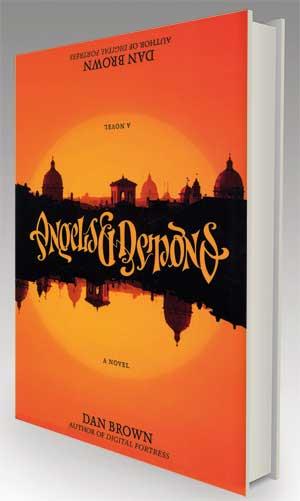Reply To:
Name - Reply Comment
One can only be amazed at how Dan Brown weaves fiction and reality together. From Digital Fortress to Origin, Brown has always kept the reader turning pages  to see what the protagonist in his books, Robert Langdon would face next. The character Robert Langdon was inspired by Prof. John Langdon, the creative architect of ambigrams found in his masterpieces. Prof. Langdon was the architect of the Illuminati ambigram and the Diamond, seen in Brown’s mystery-thriller novel Angels and Demons.
to see what the protagonist in his books, Robert Langdon would face next. The character Robert Langdon was inspired by Prof. John Langdon, the creative architect of ambigrams found in his masterpieces. Prof. Langdon was the architect of the Illuminati ambigram and the Diamond, seen in Brown’s mystery-thriller novel Angels and Demons.
In an exclusive interview, Daily Mirror the had the privileged to speak to Prof. Langdon himself, who spoke about his work, his experience working with Brown and how he likes to play around with words.
Excerpts :
"When he began writing his third novel, he wanted to use the same title, and the ambigram for the book cover"
 Q Do you recall the first time you discovered an ambigram?
Q Do you recall the first time you discovered an ambigram?
I do recall that moment clearly. I had been trying to design tessellated letters and words the way Escher had tessellated birds and fish. I had recently seen invertible logos for VISTA and NEW MAN, but they were so simple (removing a stroke from the A in VISTA, and using a lower case E in NEW) that I thought one had to be lucky to have the opportunity to design a logo like those. I wrote the word HEAVEN on a page of my sketchbook, left the room, and when I came back, I saw the page upside down. I saw that HEAVEN could be designed as a rotationally symmetrical word. It was a ‘Eureka’ moment. I was really excited! Not long after I saw an invertible 72 by Herb Lubalin and Tom Carnase, and realized that by careful drawing using very subtle changes, more words would be willing to cooperate.
"The subject matter of almost all my paintings is words"
Q Tell us about your discovery of Taoist philosophy and how it influenced your work.
While I was in college, a friend showed me the yin yang symbol. I felt as though I understood the enormity of its implications immediately. I didn’t bother to research it — I just began to draw it in as many different ways as I could think of. What does it look like on the back? What if I pull the pieces apart and put them back together in a different way? What if it were square? What other symbols and other images did it remind me of? Over time, I learned a lot about the world and the way it works, just by playing with the yin/yang symbol. Years later,  when I first read about Taoism, I found that I already knew and understood most of what I was reading.
when I first read about Taoism, I found that I already knew and understood most of what I was reading.
Q How did you feel when Dan Brown commissioned you to draw the ‘Illuminati’ ambigram and the Diamond?
I had already created the Angels & Demons ambigram for Dan when he was a musician. It was the title of his last CD. When he began writing his third novel, he wanted to use the same title, and the ambigram for the book cover. And he wanted some ambigrams to include in the story. I was excited about having my work included in a novel, even though he was not a well-known author at that point.
"He wanted them in a style that was not contemporary, and that looked sinister"
Q Tell us about your experience designing it. (How long did you take to design it, what were the challenges etc.)
Dan wanted ambigrams for Earth, Air, Fire, and Water and all four in one ambigram along with the word Illuminati. He wanted them in a style that was not contemporary, and that looked sinister. Normally, the manipulations required to make an ambigram work determine the style of the ambigram.
I had already created Earth, Air, Fire, and Water ambigrams, but in a very different style — almost psychedelic. It was easy to redo them in the Blackletter style. But it was a bit more challenging to get all four into a single unit, but it didn’t take a terribly long time — not nearly as long as it took me to do the Angels & Demons ambigram. I told Dan that Illuminati had proved to be uncooperative, and that I didn’t think it could be a good ambigram, but he insisted that it was critically necessary for the story, so I persevered, and eventually solved it.
Q Your work inspired Brown to introduce the protagonist Robert Langdon into his books. But there’s no such career as a symbologist. What do you have to say about that?
I’m sure there have been people who made the study of symbols their life’s work, but no one ever called them symbologists. It’s an appropriate name though, right? Dan patterned Robert Langdon after both himself and me. I love symbols and design them as part of my graphic design specialty and logo design. That seems to be why he made Robert Langdon a symbologist.
"I told Dan that Illuminati had proved to be uncooperative, and that I didn’t think it could be a good ambigram"
 Q One of the key components of an ambigram is symmetry. Artists such as Da Vinci used symmetry to a great extent to complete their works. Does it mean that art and mathematics have a deeper relationship?
Q One of the key components of an ambigram is symmetry. Artists such as Da Vinci used symmetry to a great extent to complete their works. Does it mean that art and mathematics have a deeper relationship?
As you say, most ambigrams involve symmetry. But symmetry is not on my mind when I start developing an ambigram. I’m just trying to get one letter to look like another letter when it’s reflected or inverted. Of course, I know that when I’m successful, symmetry will be the result, and that symmetry is inherently attractive to the human eye. This is almost certainly because virtually everything and every process in the universe has an underpinning of one kind of symmetry or another.
Q In addition to typography you paint as well. How do you blend symmetry, illusion and philosophy together? (Perhaps with an example)
The subject matter of almost all my paintings is words. In my paintings the symmetry will usually be more linguistic, using words like IN and OUT, UP and DOWN, etc. I do have an ongoing series of paintings that are created to resemble Rorschach inkblots, in which I either create a word with mirror image symmetry, or find the suggestion of a human face and enhance by way of collage — pasting in a photograph of a mouth — thereby helping the viewer see the face that I saw.
Ultimately, the focus of all my work is ideas. Ideas are what philosophy is made of. Ideas can be communicated both verbally and visually. My genetic heritage has given me deep interests in both, and so my purpose in life is to bring the two together.
In my mind, illusion is an expression of the yin/yang principle. Some words sound the same as other words, but are spelled differently. Some are spelled the same but sound differently. Yin is the same as yang, but for changes in colour and orientation. Colour and orientation make them different. They are like a thesis and an antithesis. The Tao is synthesis. All of these ideas are explored in depth in my book Wordplay, where 60-some ambigrams are accompanied by brief philosophical essays. My philosophies are elaborated in more depth at my website, johnLangdon.net